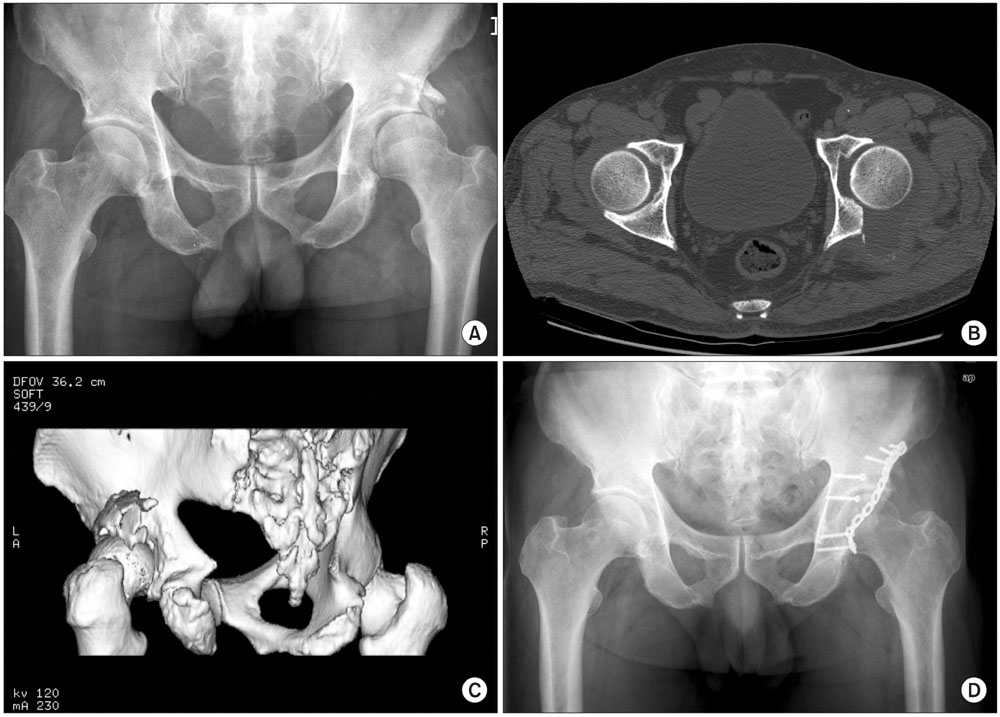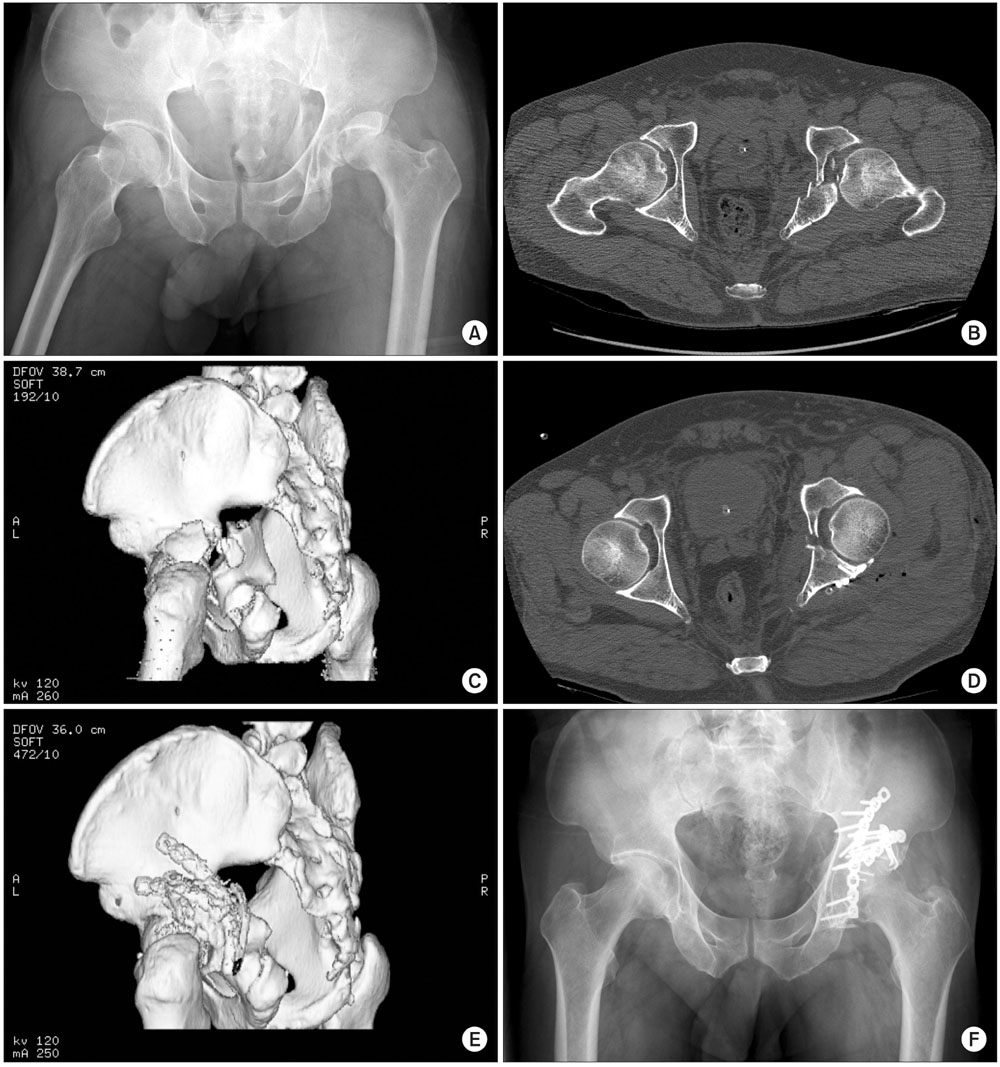Clin Orthop Surg.
2011 Jun;3(2):114-120. 10.4055/cios.2011.3.2.114.
Reconstruction of Acetabular Posterior Wall Fractures
- Affiliations
-
- 1Department of Orthopaedic Surgery and Medical Research Institute, Pusan National University Hospital, Busan, Korea. kimht@pusan.ac.kr
- KMID: 1719307
- DOI: http://doi.org/10.4055/cios.2011.3.2.114
Abstract
- BACKGROUND
The results after acetabular fracture are primarily related to the quality of the articular reduction. We evaluated the results of internal fixation of posterior wall fractures with using three-step reconstruction.
METHODS
Thirty-three patients (mean age at the time of injury, 47.9 years; 28 males and 5 females) were followed for a minimum of 2 years after surgery. The three-step reconstruction included 1) preservation of soft tissues and reduction of the marginally impacted osteochondral (articular) fragments using screws, 2) filling the impacted cancellous void with a bone graft, and 3) reinforcement with buttress-plating. Clinical evaluation was done according to the criteria of D'aubigne and Postel, while the radiological criteria were those of Matta. The associated injuries and complications were evaluated.
RESULTS
The clinical results were excellent in 15 (45.5%) patients and they were good in 5 (15.2%), (i.e., satisfactory in 60.7%), while the radiologic results were excellent in 10 (30.3%) and good in 14 (42.4%) (satisfactory in 72.7%). Heterotopic ossification was common, but this did not require excision, even without prophylactic treatment with indomethacin. Deep infection was the worst complication and this was accompanied by a poor outcome.
CONCLUSIONS
This study confirms that three-step reconstruction facilitates accurate and firm reduction of displaced posterior wall fractures of the acetabulum. Therefore, we anticipate less long-term arthrosis in the patients treated this way.
Keyword
MeSH Terms
Figure
Cited by 1 articles
-
Fucntional and Radiological Outcome of Surgical Management of Acetabular Fractures in Tertiary Care Hospital
Faizan Iqbal, Intikhab Taufiq, Muhammad Kazim Raheem Najjad, Naveed Khan, Osama Bin Zia
Hip Pelvis. 2016;28(4):217-224. doi: 10.5371/hp.2016.28.4.217.
Reference
-
1. Letournel E, Judet R. Fractures of the acetabulum. 1993. 2nd ed. Berlin: Springer-Verlag.2. Matta JM. Fractures of the acetabulum: accuracy of reduction and clinical results in patients managed operatively within three weeks after the injury. J Bone Joint Surg Am. 1996. 78(11):1632–1645.3. Mayo KA. Open reduction and internal fixation of fractures of the acetabulum: results in 163 fractures. Clin Orthop Relat Res. 1994. (305):31–37.
Article4. Brumback RJ, Holt ES, McBride MS, Poka A, Bathon GH, Burgess AR. Acetabular depression fracture accompanying posterior fracture dislocation of the hip. J Orthop Trauma. 1990. 4(1):42–48.
Article5. Baumgaertner MR. Fractures of the posterior wall of the acetabulum. J Am Acad Orthop Surg. 1999. 7(1):54–65.
Article6. Moed BR, Carr SE, Watson JT. Open reduction and internal fixation of posterior wall fractures of the acetabulum. Clin Orthop Relat Res. 2000. (377):57–67.
Article7. Ebraheim NA, Patil V, Liu J, Sanford CG Jr, Haman SP. Reconstruction of comminuted posterior wall fractures using the buttress technique: a review of 32 fractures. Int Orthop. 2007. 31(5):671–675.
Article8. Letournel E, Judet R, Elson RA. Fractures of the acetabulum. 1993. New York: Springer.9. Judet R, Judet J, Letournel E. Fractures of the acetabulum: classification and surgical approaches for open reduction. Preliminary report. J Bone Joint Surg Am. 1964. 46(8):1615–1646.10. Moed BR. Wiss DA, editor. Acetabular fractures: the Kocher-Langenbeck approach. Master techniques in orthopaedic surgery: fractures. 1998. Philadelphia: Lippincott-Raven;631–656.11. Olson SA, Finkemeier CG. Posterior wall fractures. Oper Tech Orthop. 1999. 9(3):148–160.
Article12. D'aubigne RM, Postel M. Functional results of hip arthroplasty with acrylic prosthesis. J Bone Joint Surg Am. 1954. 36(3):451–475.13. Brooker AF, Bowerman JW, Robinson RA, Riley LH Jr. Ectopic ossification following total hip replacement: incidence and a method of classification. J Bone Joint Surg Am. 1973. 55(8):1629–1632.14. Moed BR, Smith ST. Three-view radiographic assessment of heterotopic ossification after acetabular fracture surgery. J Orthop Trauma. 1996. 10(2):93–98.
Article15. Ficat P, Arlet J. Hungerford DS, editor. Necrosis of the femoral head. Ischemia and necrosis of bone. 1980. Baltimore: Williams and Wilkins;53–74.16. Kaempffe FA, Bone LB, Border JR. Open reduction and internal fixation of acetabular fractures: heterotopic ossification and other complications of treatment. J Orthop Trauma. 1991. 5(4):439–445.17. Wright R, Barrett K, Christie MJ, Johnson KD. Acetabular fractures: long-term follow-up of open reduction and internal fixation. J Orthop Trauma. 1994. 8(5):397–403.
Article18. Kumar A, Shah NA, Kershaw SA, Clayson AD. Operative management of acetabular fractures: a review of 73 fractures. Injury. 2005. 36(5):605–612.19. Chiu FY, Chen CM, Lo WH. Surgical treatment of displaced acetabular fractures: 72 cases followed for 10 (6-14) years. Injury. 2000. 31(3):181–185.
Article20. Deo SD, Tavares SP, Pandey RK, El-Saied G, Willett KM, Worlock PH. Operative management of acetabular fractures in Oxford. Injury. 2001. 32(7):581–586.
Article21. Petsatodis G, Antonarakos P, Chalidis B, Papadopoulos P, Christoforidis J, Pournaras J. Surgically treated acetabular fractures via a single posterior approach with a follow-up of 2-10 years. Injury. 2007. 38(3):334–343.
Article22. Giannoudis PV, Grotz MR, Papakostidis C, Dinopoulos H. Operative treatment of displaced fractures of the acetabulum: a meta-analysis. J Bone Joint Surg Br. 2005. 87(1):2–9.23. Murphy D, Kaliszer M, Rice J, McElwain JP. Outcome after acetabular fracture: prognostic factors and their interrelationships. Injury. 2003. 34(7):512–517.24. Liebergall M, Mosheiff R, Low J, Goldvirt M, Matan Y, Segal D. Acetabular fractures: clinical outcome of surgical treatment. Clin Orthop Relat Res. 1999. (366):205–216.25. Moed BR, McMichael JC. Outcomes of posterior wall fractures of the acetabulum: surgical technique. J Bone Joint Surg Am. 2008. 90:Suppl 2 Pt 1. 87–107.26. Moed BR, WillsonCarr SE, Watson JT. Results of operative treatment of fractures of the posterior wall of the acetabulum. J Bone Joint Surg Am. 2002. 84(5):752–758.
Article27. Johnson EE, Matta JM, Mast JW, Letournel E. Delayed reconstruction of acetabular fractures 21-120 days following injury. Clin Orthop Relat Res. 1994. (305):20–30.
Article28. Matta JM, Merritt PO. Displaced acetabular fractures. Clin Orthop Relat Res. 1988. (230):83–97.
Article29. Helfet DL, Schmeling GJ. Management of complex acetabular fractures through single nonextensile exposures. Clin Orthop Relat Res. 1994. (305):58–68.
Article
- Full Text Links
- Actions
-
Cited
- CITED
-
- Close
- Share
- Similar articles
-
- Finite Element Analysis of a New Acetabular Plate in the Combined Posterior Column and Posterior Acetabular Wall Fracture Model
- Posterior Acetabular Coverage of the Femoral Head in Sport-Related Posterior Hip Dislocation or Subluxation
- Arthroscopic Reduction and Transportal Screw Fixation of Acetabular Posterior Wall Fracture: Technical Note
- Results of Treatment for Acetabular Fracture involving Posterior Wall
- Anatomical Results According to Fracture Pattern after Surgical Treatment of Acetabular Fractures



